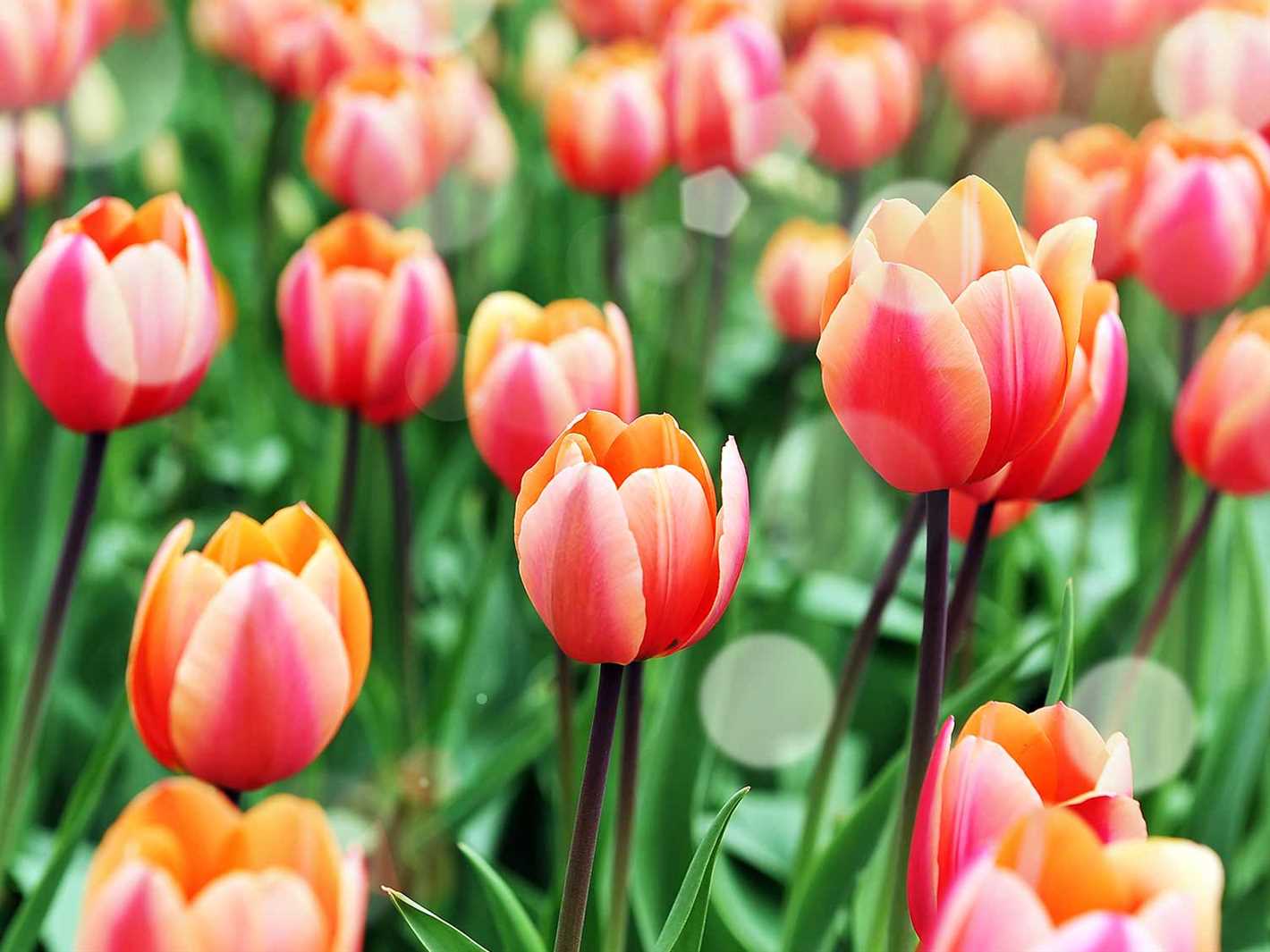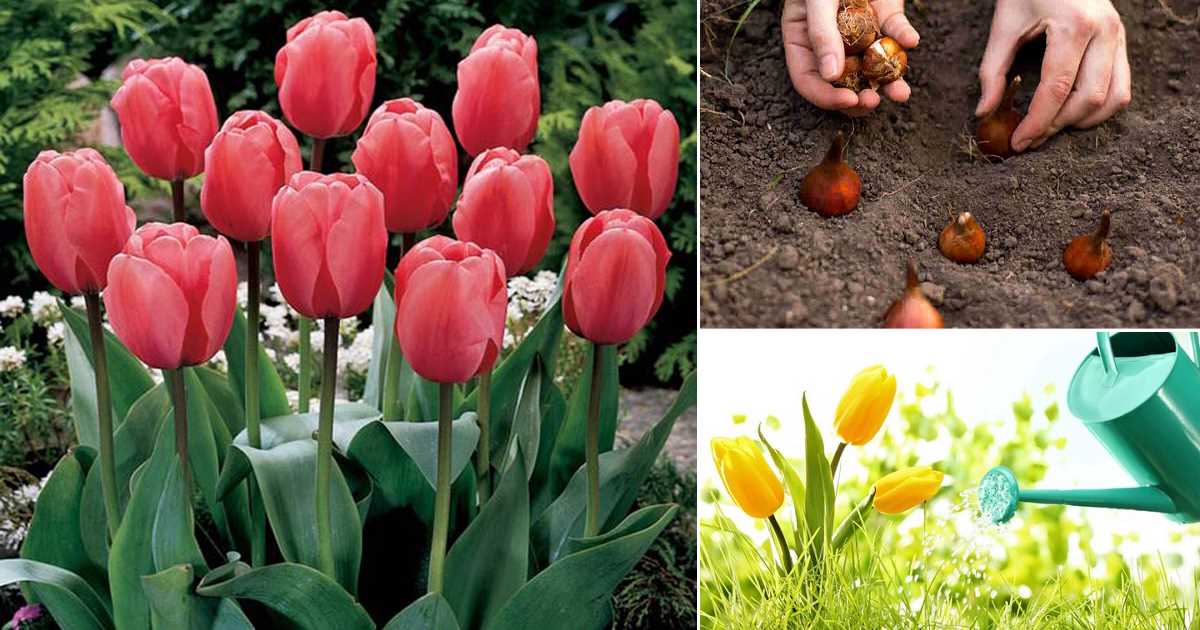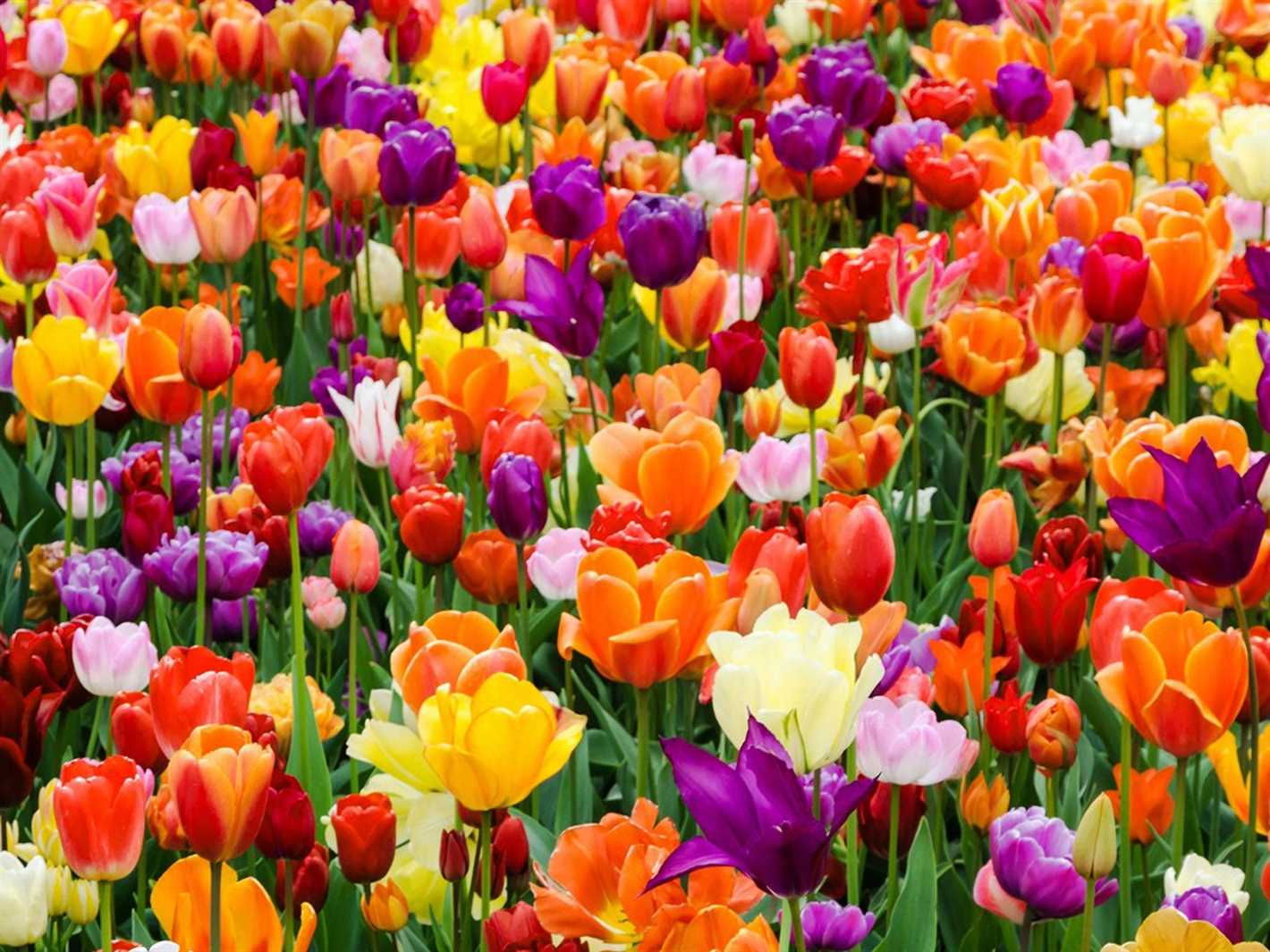- Tulips Cultivation
- Choose the Right Location
- Planting Tulip Bulbs
- Watering
- Fertilizing
- Protecting from Pests and Diseases
- Deadheading and Dividing
- Tips for Growing and Caring for Tulip Plants
- Choosing the Right Location
- Selecting the Right Tulip Varieties
- 1. Climate Suitability
- 2. Flower Color
- 3. Blooming Time
- 4. Height
- 5. Fragrance
- 6. Disease Resistance
- 7. Bulb Size
- 8. Multi-flowering
- 9. Durability
- 10. Special Varieties
- Planting Tulip Bulbs
- 1. Choose the Right Time
- 2. Select the Right Location
- 3. Prepare the Soil
- 4. Plant the Bulbs
- 5. Water and Mulch
- 6. Maintenance
- 7. Enjoy the Blooms
- Providing Proper Watering
- Fertilizing Tulip Plants
- 1. Timing
- 2. Fertilizer Type
- 3. Application Method
- 4. Quantity
- 5. Watering
- 6. Frequency
- Protecting from Pests and Diseases
- Common Pests
- Common Diseases
- Pruning and Deadheading Tulips
- When to Prune Tulips
- How to Deadhead Tulips
- Pruning Tulip Leaves
- Benefits of Pruning and Deadheading Tulips
- Storing Tulip Bulbs for Future Growth
- Questions and Answers:
- How do I grow tulips in pots?
- What are some common tulip plant diseases?
- When is the best time to plant tulip bulbs?
- How do I care for cut tulips?
- How long do tulips bloom for?
- Videos: How to get tulips to come back year after year
When it comes to cultivating tulips, there are a few key tips to keep in mind to ensure healthy and beautiful plants. Tulips are known for their vibrant colors and distinctive shape, making them a popular choice for gardens and floral arrangements.
To successfully grow tulips, it is important to choose the right location. Tulips thrive in areas with full sun or partial shade and well-drained soil. They prefer cooler climates and can be planted in either the spring or fall, depending on your location.
When planting tulips, it is recommended to dig a hole that is about two to three times deeper than the bulb’s height. This will ensure that the bulbs have enough space to grow and develop. It is also important to space the bulbs evenly to allow for proper air circulation and prevent overcrowding.
“Tulips are known for their vibrant colors and distinctive shape, making them a popular choice for gardens and floral arrangements.”
Proper care is essential for the health and longevity of tulip plants. Watering is important, especially during dry periods, but excessive watering can cause the bulbs to rot. It is best to water thoroughly and then allow the soil to dry out slightly before watering again.
After the tulips have finished blooming, it is important to leave the foliage intact until it turns yellow and dies back naturally. This allows the bulbs to store energy for the following year’s growth. Once the foliage has completely died back, it can be trimmed off at the base.
By following these tips for growing and caring for tulips, you can enjoy the beauty of these stunning flowers in your garden year after year.
Tulips Cultivation

Tulips are beautiful and vibrant flowers that are popular for their bright colors and unique shapes. They can be grown in gardens or pots and are relatively easy to care for. Here are some tips for successfully cultivating tulips:
Choose the Right Location

- Tulips need a sunny location with well-drained soil.
- Avoid areas with excessive moisture, as it can cause the bulbs to rot.
Planting Tulip Bulbs
- Plant tulip bulbs in the fall, before the ground freezes.
- Dig a hole about 6-8 inches deep and place the bulb with the pointed end facing upwards.
- Space the bulbs about 4-6 inches apart.
- Cover the bulbs with soil and water thoroughly.
Watering
- Water the tulips regularly, keeping the soil moist but not waterlogged.
- During dry spells, provide additional water to prevent the bulbs from drying out.
Fertilizing
- Apply a slow-release fertilizer or organic compost in the spring when the tulips begin to emerge.
- Avoid using high nitrogen fertilizers, as they can promote foliage growth at the expense of flowers.
Protecting from Pests and Diseases

- Keep an eye out for common pests such as aphids and slugs.
- Use organic pest control methods or insecticidal soap to manage the pests.
- Avoid overwatering, as it can lead to fungal diseases such as root rot.
Deadheading and Dividing
- Remove faded flowers to prevent the tulips from expending energy on seed production.
- After the tulips have finished blooming, allow the foliage to die back naturally before removing it.
- Divide overcrowded tulip bulbs every few years to ensure healthy growth.
By following these tips, you can enjoy a beautiful display of tulips in your garden or pots. With proper care, tulips will continue to come back year after year, providing a burst of color in the spring.
Tips for Growing and Caring for Tulip Plants
Tulips are beautiful spring flowers that can add a pop of color to any garden. Here are some tips for growing and caring for tulip plants:
- Choose a sunny location: Tulips thrive in full sun, so make sure to choose a spot in your garden that receives at least 6 hours of direct sunlight each day.
- Prepare the soil: Before planting tulips, it’s important to prepare the soil. Tulips prefer well-draining soil that is consistently moist but not waterlogged. You can improve the soil’s drainage by adding organic matter, such as compost or peat moss.
- Plant at the right depth: When planting tulip bulbs, be sure to follow the recommended planting depth, which is usually about 6 inches deep. Planting bulbs too shallow or too deep can affect their growth and flowering.
- Water regularly: Tulips need regular watering, especially during the growing season. Keep the soil moist but not waterlogged, as overly wet soil can cause the bulbs to rot.
- Apply fertilizer: To promote healthy growth and vibrant blooms, fertilize your tulip plants once or twice a year. Use a balanced fertilizer with a ratio of 10-10-10 or similar.
- Deadhead spent blooms: After tulips have finished blooming, it’s important to deadhead the spent blooms. This will prevent the plants from wasting energy on seed production and allow the bulbs to store energy for next year’s growth.
- Protect from pests: Tulips are sometimes susceptible to pests such as aphids and slugs. You can protect your plants by regularly inspecting them for signs of infestation and taking appropriate measures, such as using organic insecticides or creating barriers.
- Leave foliage intact: Once tulips have finished blooming, it’s tempting to remove the foliage. However, it’s important to leave the foliage intact until it turns yellow and withers naturally. This allows the bulbs to store nutrients for the following year’s growth.
- Consider companion planting: Tulips can benefit from companion planting. Planting tulips alongside other plants, such as daffodils or grape hyacinths, can help deter pests and provide a visually appealing combination of colors and textures.
- Protect bulbs during winter: Tulip bulbs are generally hardy, but in colder climates, they may benefit from some winter protection. Consider applying a layer of mulch or covering the planting area with a layer of straw or leaves to insulate the bulbs from extreme cold.
By following these tips, you can successfully grow and care for tulip plants and enjoy their beautiful blooms year after year.
Choosing the Right Location
When it comes to growing tulips, choosing the right location is crucial for their success. Here are some important factors to consider:
- Sunlight: Tulips thrive in full sunlight, so it’s important to choose a location with at least 6 hours of direct sunlight per day. Avoid planting them in areas with heavy shade.
- Soil: Tulips prefer well-drained soil that is rich in organic matter. Before planting, prepare the soil by removing any weeds or rocks and adding compost or rotted manure to improve its fertility.
- Temperature: Tulips are cold-hardy plants and require a period of winter dormancy in order to bloom. Choose a location with cold winters where the soil regularly freezes, as this will help stimulate the tulips’ growth.
- Protection: Consider planting tulips in a location that offers some protection from strong winds. Wind can damage the delicate flowers and cause them to break or fall over.
By carefully considering these factors, you can choose the perfect location for your tulips to grow and thrive.
Selecting the Right Tulip Varieties

When it comes to selecting tulip varieties for your garden, there are many options to choose from. Here are some factors to consider:
1. Climate Suitability

One important factor to consider when selecting tulip varieties is your climate. Tulips thrive in cool climates with cold winters and mild springs. If you live in a warmer climate, you may need to choose tulip varieties that are more tolerant of heat.
2. Flower Color
Tulips come in a wide range of colors, including red, yellow, pink, purple, and white. Consider the color scheme of your garden or the specific color you prefer when selecting tulip varieties.
3. Blooming Time

Tulip varieties have different blooming times, with early, mid, and late-season varieties available. If you want to have tulips blooming throughout the spring, you can choose a combination of early, mid, and late blooming varieties.
4. Height
Tulip varieties also vary in height, with some being shorter and others taller. Consider the desired height for your garden or flowerbed when selecting tulip varieties.
5. Fragrance
While not all tulip varieties have a fragrance, some do. If you want your garden to have a pleasant scent, you can choose tulip varieties that are known for their fragrance.
6. Disease Resistance
Some tulip varieties are more resistant to diseases like tulip fire or tulip mosaic virus. If you want to minimize the risk of these diseases affecting your tulips, you can choose disease-resistant varieties.
7. Bulb Size
Tulip bulbs come in different sizes, and larger bulbs generally produce bigger and stronger flowers. If you want large, showy tulips, choose tulip varieties with large bulbs.
8. Multi-flowering
Some tulip varieties produce multiple blooms per bulb, creating a more dramatic effect. If you want your tulips to have a fuller look, consider selecting multi-flowering varieties.
9. Durability
Consider the durability of the tulip variety you choose. Some varieties are more resistant to wind, rain, and other weather conditions, making them suitable for areas with harsh weather.
10. Special Varieties
Lastly, consider any special varieties that caught your attention. There are unique tulip varieties available, such as parrot tulips with fringed petals or double tulips with multiple layers of petals. These special varieties can add a unique touch to your garden.
By considering these factors, you can select the right tulip varieties that will thrive in your garden and meet your visual preferences.
Planting Tulip Bulbs

Planting tulip bulbs is an exciting and rewarding process that can result in beautiful blooms and vibrant colors in your garden. Whether you are a beginner or an experienced gardener, here are some tips to help you successfully plant your tulip bulbs.
1. Choose the Right Time
Tulip bulbs should be planted in the fall, ideally 6-8 weeks before the first frost. This allows them to establish roots before the cold winter sets in. If you live in a warmer climate, you can also plant tulip bulbs in late winter or early spring.
2. Select the Right Location
Tulips prefer well-draining soil and full sunlight. Choose a location in your garden that receives at least 6 hours of direct sunlight each day. Avoid areas with excessive moisture, as this can lead to bulb rot.
3. Prepare the Soil
Before planting, prepare the soil by removing any weeds or debris. Loosen the soil using a garden fork or tiller to a depth of 12-14 inches. Incorporate organic matter, such as compost or peat moss, to improve the soil’s fertility and drainage.
4. Plant the Bulbs
Dig a hole that is 6-8 inches deep, depending on the size of the bulb. Place the bulb in the hole with the pointed end facing up. Space the bulbs about 4-6 inches apart to allow enough room for growth. Once planted, cover the bulbs with soil and gently firm it down.
5. Water and Mulch
After planting, water the area thoroughly to settle the soil. Apply a layer of mulch, such as straw or shredded leaves, to protect the bulbs from extreme temperature fluctuations and to conserve moisture.
6. Maintenance
Throughout the growing season, water the tulips regularly, especially during dry spells. However, avoid overwatering as this can cause the bulbs to rot. Remove any weeds that may compete with the tulips for nutrients and space.
7. Enjoy the Blooms
Depending on the variety, tulips typically bloom for 1-3 weeks in spring. Once the blooms fade, deadhead the flowers to prevent seed production and redirect energy towards bulb formation.
By following these planting tips, you can ensure that your tulip bulbs grow into healthy plants with stunning blooms. Remember to plan ahead and choose a variety of tulips that suits your garden style and color preferences. Happy planting!
Providing Proper Watering
Tulips require adequate water in order to grow and bloom properly. Here are some tips on how to provide proper watering for your tulip plants:
- Watering frequency: Tulips need to be watered regularly, especially during their active growth period. Water the plants deeply once a week, ensuring that the soil is evenly moist. However, be careful not to overwater, as excessive moisture can lead to root rot.
- Watering amount: Give your tulips enough water to thoroughly saturate the soil. Aim to water the plants to a depth of at least 6 inches. This will encourage deep root growth and make the plants more resilient to drought conditions.
- Time of day: Water your tulips early in the morning or late in the afternoon. This allows the plants to absorb the moisture before the heat of the day evaporates it. Avoid watering in the evening, as the damp conditions can promote fungal diseases.
- Watering method: Use a gentle spray or a drip irrigation system to water your tulips. This helps prevent soil erosion and allows the water to penetrate deeply into the soil. Avoid overhead watering, as it can cause the flowers to become waterlogged and prone to disease.
- Container-grown tulips: If you are growing tulips in containers, make sure they have proper drainage holes to prevent waterlogging. Water the containers thoroughly until the excess water drains out, and always empty the saucers to avoid soggy soil conditions.
By following these watering tips, you can ensure that your tulip plants receive the right amount of moisture for optimal growth and flowering.
Fertilizing Tulip Plants
Tulips are beautiful flowers that require proper care and nutrition to thrive. Fertilizing tulip plants is an important aspect of their care that can help enhance their growth and promote stunning blooms. Here are some tips on fertilizing tulip plants:
1. Timing
It’s crucial to apply fertilizer at the right time to ensure maximum efficiency. The best time to fertilize tulip plants is during the fall, after they have finished blooming and the foliage starts to yellow. Applying fertilizer at this time allows the bulbs to absorb nutrients and store them for next year’s growth.
2. Fertilizer Type
When fertilizing tulip plants, it’s important to choose the right type of fertilizer. A balanced, slow-release fertilizer with equal amounts of nitrogen, phosphorus, and potassium (N-P-K) is ideal for tulips. This ensures that the plants receive a well-rounded mix of essential nutrients.
3. Application Method
There are two main methods for applying fertilizer to tulip plants: top dressing and soil incorporation.
- Top Dressing: Sprinkle the fertilizer granules evenly around the base of the tulip plants, avoiding direct contact with the foliage. Water in the fertilizer well after application to allow it to reach the roots.
- Soil Incorporation: Before planting the tulip bulbs, mix the fertilizer into the soil at the recommended rate. This ensures that the nutrients are evenly distributed in the planting area.
4. Quantity
When it comes to fertilizing tulip plants, less is more. Over-fertilization can lead to excessive foliage growth and weak flowers. Follow the instructions on the fertilizer packaging for the recommended application rate. Generally, a handful or two of granular fertilizer per square yard is sufficient.
5. Watering
After applying fertilizer, it’s important to water the tulip plants thoroughly. This helps to dissolve the fertilizer and deliver the nutrients to the roots. Ensure that the soil is moist but not overly saturated, as excessive water can lead to bulb rot.
6. Frequency
Tulip plants generally require fertilization once a year, in the fall. However, if the plants are growing in poor soil or showing signs of nutrient deficiency, a mid-spring application of a balanced liquid fertilizer can provide a boost.
By following these fertilizing tips, you can help your tulip plants grow strong and produce vibrant, beautiful blooms year after year.
Protecting from Pests and Diseases
Tulips are susceptible to a variety of pests and diseases that can negatively impact their growth and health. By taking preventive measures and implementing proper care practices, you can significantly reduce the risk of pests and diseases affecting your tulip plants.
Common Pests
- Aphids: These small insects feed on the sap of tulip plants, causing leaves to curl and turn yellow. Regularly inspect your plants for aphids, and if detected, wash them off with a strong stream of water or apply insecticidal soap.
- Slugs and snails: These pests can cause extensive damage to tulip foliage and flowers. Use physical barriers like copper tape or diatomaceous earth to prevent slugs and snails from reaching your plants. Additionally, you can set up beer traps or handpick them to control their population.
- Tulip bulb flies: These flies lay their eggs near or on tulip bulbs, leading to larval infestation and subsequent damage to bulbs and plant growth. To prevent this, ensure proper drainage to avoid waterlogged soil and remove any decaying plant material that may attract the flies.
Common Diseases
- Tulip fire: This fungal disease causes brown spots with purple edges on leaves, eventually leading to wilting and death of the plant. Remove and destroy infected plants promptly to prevent the spread of the disease. Avoid overhead watering and provide good air circulation to reduce the chances of infection.
- Botrytis blight: This fungal disease thrives in cool and damp conditions, causing gray mold to appear on tulip petals and foliage. Proper spacing between plants and removing dead leaves can help prevent the disease. Treat affected plants with a fungicide if necessary.
- Root rot: Overwatering and poorly draining soil can lead to root rot, which causes the roots to decay and turn mushy. Ensure that your tulips are planted in well-draining soil and avoid overwatering. If you suspect root rot, remove the affected bulbs and replant in fresh soil.
Regularly monitoring your tulip plants for signs of pests and diseases is crucial for early detection and control. By providing proper care, such as well-draining soil, appropriate spacing, and maintaining good hygiene practices, you can protect your tulips and ensure their healthy growth.
Pruning and Deadheading Tulips
Pruning and deadheading tulips are important tasks in maintaining the health and appearance of your tulip plants. By removing spent flowers and leaves, you can encourage new growth, improve the overall shape of the plant, and prevent diseases.
When to Prune Tulips
Pruning tulips should be done after the flowers have faded and the petals have dropped off. This is usually in late spring or early summer, depending on the specific variety and climate. It’s important to wait until the foliage has turned yellow and started to wither before pruning.
How to Deadhead Tulips
Deadheading tulips involves the removal of the faded flowers to prevent the plant from wasting energy on seed production. To deadhead your tulips, simply cut off the flower stalk with a pair of clean garden shears or scissors. Make sure to cut the stalk just above the first set of healthy leaves.
Pruning Tulip Leaves
After the tulip flowers have been deadheaded, you will also need to prune the leaves. However, it’s important to allow the leaves to remain on the plant until they turn yellow and start to die back naturally. This process, known as “ripening,” allows the tulip bulbs to gather energy for next year’s growth.
Once the leaves have yellowed and started to wither, you can prune them back. Use clean garden shears or scissors to cut the leaves off at ground level. Be careful not to damage the bulbs when pruning the foliage.
Benefits of Pruning and Deadheading Tulips
Pruning and deadheading tulips offer several benefits. By removing spent flowers and foliage, you can:
- Redirect the energy of the plant towards bulb formation and storage for the next season;
- Prevent the formation of seeds, which can drain the plant’s resources;
- Improve the overall appearance of the plant;
- Reduce the risk of diseases, as removing decaying flowers and leaves can prevent the spread of fungal infections;
- Encourage the growth of new foliage, which can help to strengthen the bulbs and promote better flower production in the future.
By regularly pruning and deadheading your tulip plants, you can ensure that they stay healthy, vibrant, and ready to bloom year after year.
Storing Tulip Bulbs for Future Growth
Once the tulip flowers have faded and the plant begins to die back, it’s time to start thinking about storing the bulbs for future growth. Storing tulip bulbs properly will ensure their survival and promote healthy growth in the next season.
Here are some tips for storing tulip bulbs:
- Wait until the foliage has turned yellow: After the tulip flowers have finished blooming, allow the foliage to turn yellow and wither completely. This allows the bulb to absorb nutrients and energy for next year’s growth. Avoid cutting back the foliage prematurely.
- Gently lift the bulbs: Use a garden fork or shovel to gently lift the tulip bulbs from the ground. Be careful not to damage the bulbs or their roots.
- Remove excess soil: Gently remove any excess soil from the bulbs, being careful not to remove the papery outer skin. Do not wash the bulbs, as this can lead to rotting.
- Cure the bulbs: Allow the bulbs to cure in a well-ventilated area for a few days. This helps to dry out any moisture and prevent rotting.
- Inspect and discard damaged bulbs: Before storing, carefully inspect the bulbs for any signs of damage or disease. Discard any bulbs that are soft, moldy, or show signs of rot.
- Choose a storage location: Find a cool, dark, and dry location for storing the bulbs, such as a basement or garage. The temperature should be around 50-60°F (10-15°C).
- Use proper storage containers: Place the bulbs in a breathable container, such as a paper bag or mesh bag, to allow for air circulation. Avoid using plastic bags, as they can trap moisture and lead to rotting.
- Label the storage containers: It’s helpful to label the storage containers with the variety and color of tulip bulbs inside. This will make it easier to identify them when it’s time to plant again.
- Store bulbs upright: Place the tulip bulbs in the storage container upright, with the pointy end facing upwards. This is the direction the new growth will emerge from.
- Check on the bulbs periodically: During the storage period, check on the bulbs occasionally to ensure they are not rotting or becoming damaged. Discard any bulbs that show signs of deterioration.
By following these storage tips, you can ensure that your tulip bulbs remain healthy and ready for future growth. With proper care and storage, you can enjoy vibrant tulip blooms year after year.
Questions and Answers:
How do I grow tulips in pots?
To grow tulips in pots, start by selecting a pot that is at least 6 inches deep and has drainage holes. Fill the pot with a well-draining potting mix, leaving about 1 inch of space at the top. Plant the tulip bulbs about 4-6 inches apart and then cover them with soil until just the tips of the bulbs are visible. Water the pot thoroughly after planting and place it in a location that receives full sun. Keep the soil moist but not soggy, and fertilize the tulips every couple of weeks with a balanced bulb fertilizer. Once the tulips have finished blooming, you can remove the faded flowers but leave the foliage until it turns yellow, as this will help the bulbs store energy for next year.
What are some common tulip plant diseases?
Some common tulip plant diseases include botrytis (gray mold), tulip fire, and tulip breaking virus. Botrytis can cause gray mold on the leaves and flowers, while tulip fire is characterized by brown spots and twisted foliage. The tulip breaking virus can cause the flowers to display abnormal color patterns. Preventing these diseases involves choosing healthy bulbs, planting them in well-draining soil, and providing adequate air circulation. If your tulips do become infected, it is best to remove and destroy the affected plants to prevent further spread of the disease.
When is the best time to plant tulip bulbs?
The best time to plant tulip bulbs is in the fall, usually between September and November before the ground freezes. This allows the bulbs to establish roots before winter dormancy, resulting in stronger plants and better blooms in the spring. If you live in a colder climate, it is important to plant tulip bulbs early enough in the fall to ensure they have enough time to develop roots before the ground freezes. If you miss the fall planting window, you can also try planting tulip bulbs in early spring, although the flowers may not be as vigorous as those planted in the fall.
How do I care for cut tulips?
To care for cut tulips, start by cutting the stems at a 45-degree angle to help with water absorption. Remove any leaves that will be submerged in water and place the tulips in a clean vase filled with fresh water. It is also helpful to add a floral preservative to the water to prolong the life of the cut flowers. Keep the tulips in a cool location away from direct sunlight and change the water every few days. Trimming the stems and replacing the water regularly can help extend the vase life of cut tulips.
How long do tulips bloom for?
The blooming period of tulips can vary depending on the variety and growing conditions. On average, tulips bloom for about 1-2 weeks. Some early blooming varieties may have a shorter blooming period, while late blooming varieties can extend the flowering time. Providing proper care, such as watering and fertilizing, can help prolong the blooming period of tulips. Once the flowers start to fade, it is important to remove the faded blossoms to prevent the plant from putting energy into seed production.







